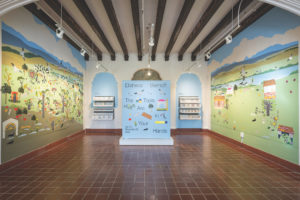On May 19 thousands of kids from San Diego to Vancouver will gather on seven West Coast beaches to pick up trash and create impressive aerial art. These kids are participating in Ocean Day, part of the California Coastal Commission’s Adopt-A-Beach Program.
Funded by the commission’s “Whale Tail” license plate sales, this project not only recruits children to be environmental stewards but teaches them how to keep trash off the beach–and out of the ocean–in the first place.
Locally, 560 second through fifth graders, primarily from underserved schools in San Francisco and Marin counties, will converge on Ocean Beach to take their “stand on the sand.”
After several hours of litter patrol, the beach will become a sandy canvas upon which the kids will arrange their bodies to create a bold visual statement: a giant bat ray. San Francisco-based artist Carter Brooks is coordinating the aerial art, which will be photographed from a helicopter. Conservation Corps North Bay/AmeriCorps intern Andrew Frostholm is designing the image.
Wendy Dalia, education director for the Richardson Bay Audubon Center and the event’s coordinator, says classroom presentations before the big day educate participants about their role in the watershed and the harmful effects of marine debris, much of which originates on land and flows down rivers and storm drains.
“We try to focus on ‘kid-solvable’ problems,” says Dalia, whether that means using fewer plastic bags, buying products with less packaging, or choosing reusable rather than disposable containers. To underscore the message, kids will not be using plastic Hefty bags to collect trash.
Dalia says it’s more important for kids to be thorough than to set records for number of bags filled. She encourages kids to comb through the sand for smaller bits of trash. These tiny pieces, often plastic, can harm the sea turtles and pelagic birds that ingest them. Other items like plastic rings and fishing line can entangle creatures, strangling them or hampering their mobility.
Aside from the educational and environmental benefits, Ocean Day offers a great opportunity for underserved kids to connect directly with the ocean.
Rain threatened to cancel last year’s event; fortunately the weather cooperated long enough for nearly 600 kids to form the image of an enormous albatross. Two of the participants rolled onto the sand in their wheelchairs.
“It was their first time on the beach, even though they go to a school that’s just blocks away,” says Dalia.
With high student turnout expected, Dalia can’t accept any more school groups for this year’s event, she is hoping to recruit 30 to 35 adults to help out.
Volunteers are needed to lay out the image’s outline, greet busses and register participants, distribute supplies, administer first aid, man the water and snack stations, and break down after the event.
To find out more about volunteering, contact Dalia at wdalia@audubon.org. Or find more general information about the Coastal Commission’s Adopt-A-Beach Program here.

.jpg)



